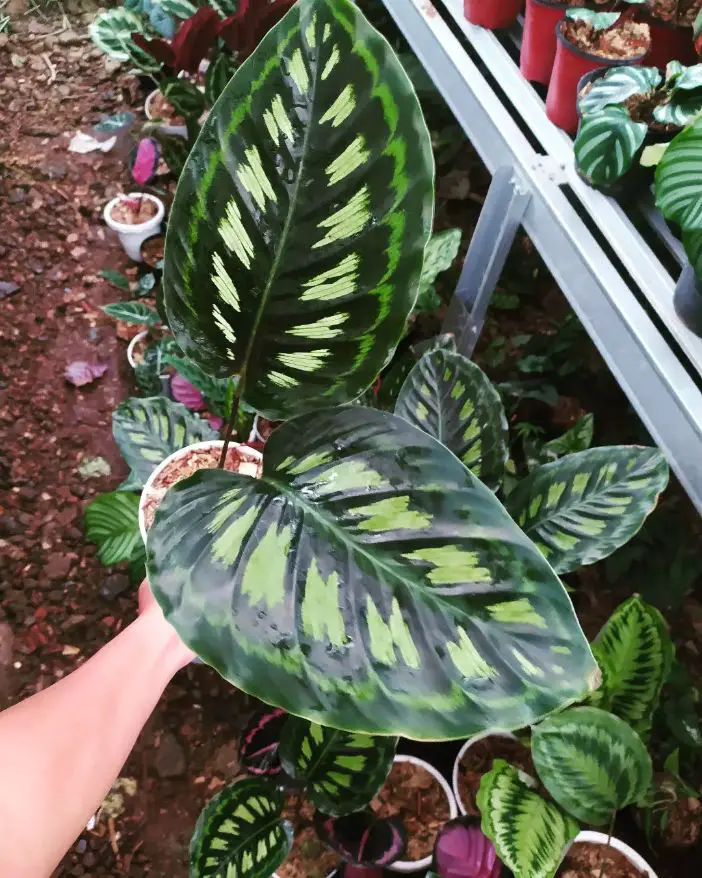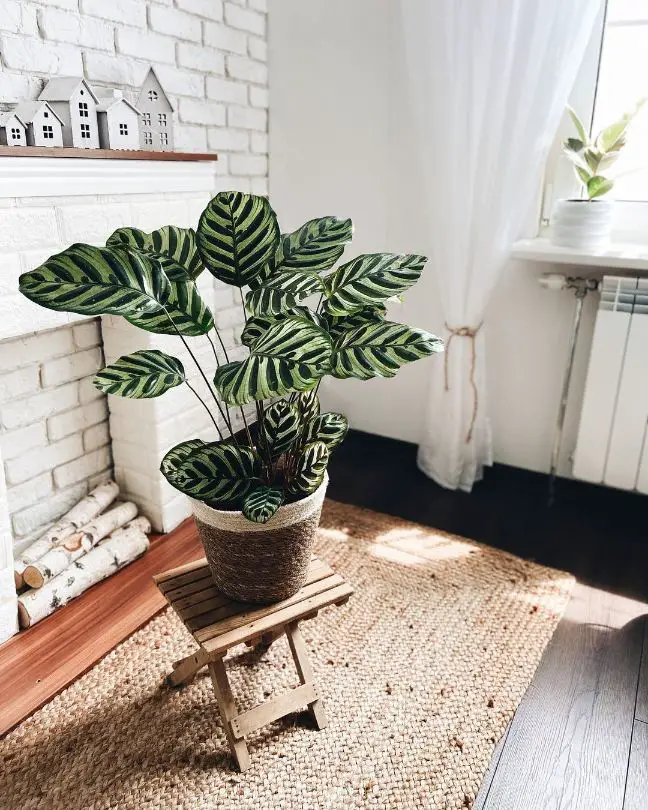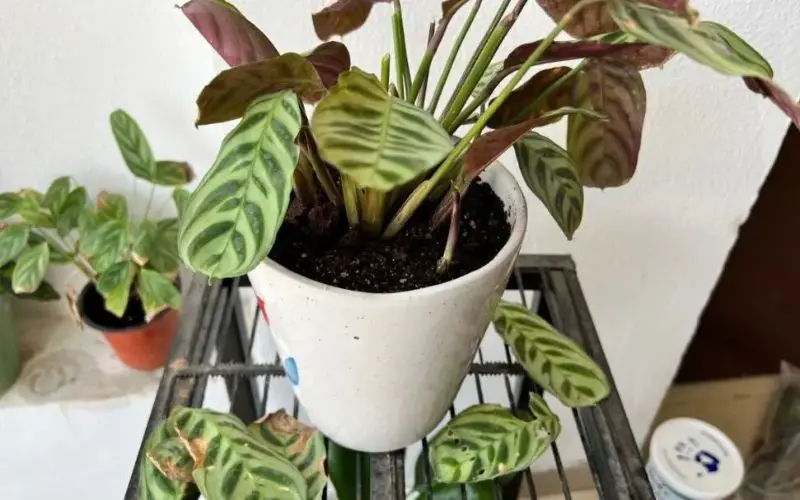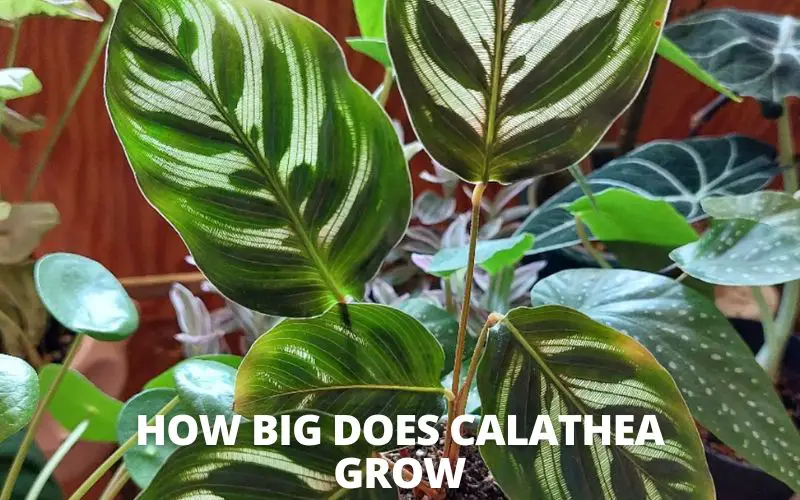Calatheas are known for their large, colorful leaves. But how big does a Calathea grow? And what factors influence its size? In this blog post, we’ll answer those questions and more. We’ll also provide tips on how to care for your Calathea so that it grows to its full potential. Thanks for reading
How big does Calathea grow?
Calathea plants are tropical evergreens that can range in size from a few inches to several feet tall. They are native to South America, where they grow in the understory of rainforests. Calathea plants are grown for their beautiful, brightly-colored leaves. The most popular varieties include the zebra plant (Calathea zebrina), peacock plant (Calathea Makoyana), and rabbit’s foot fern (Davallia Fejeensis).
Calathea plants are not fast-growing plants. When their needs are addressed, most Calathea species can grow quite quickly, reaching a mature height of around 2 feet in a year or two. They’ll get bushier but not taller after that. During the spring and summer, a healthy Calathea will normally develop a few new leaves per month.
If you reside somewhere with real winters, your plant will most likely stop growing during the colder months. Calatheas shouldn’t become completely dormant in the winter; if they shed all of their leaves, they’re probably suffering from cold shock. It should be moved to a less draughty location.

Indoor vs. Outdoor Calathea Plant Growth
Calathea plants grown in the protection of your home or workplace will not grow as swiftly or as wildly as those grown in the wild. The environment provides a lot more humidity, wind, organic fertilizers, and other important conditions for the development of the wild Calathea.
You don’t have to feel guilty about disappointing your Calathea. Floods, predators, and illnesses do not exist in the home environment, which might limit the lifespan of a wild plant.
Natural Growth Cycle of the Calathea Plant
In the winter, this houseplant goes dormant and is unlikely to develop aggressively. This is related to a decrease in average temperature as well as a shorter day duration. Over the winter, Calathea plants will not produce any new leaves or grow much in size.
How Long Does a Calathea Plant Take to Grow to Full Size?
A Calathea obtained as a young plant of a few inches can achieve maturity in as little as two to three years if properly maintained with correct care. Cuttings with just one full-sized leaf will likely reach full growth in three years or less, assuming no setbacks.

When a Calathea achieves maturity, it will stay that size for the most part as a new leaf replaces the old.
Factors Influencing the Growth and Speed of a Calathea Plant
The maintenance of a Calathea is the most important aspect in determining how quickly it grows. Giving it inadequate care won’t stop it from growing, but it will diminish its chances of being healthy.
Unless you keep to careful pruning, once you’re on the way to a full-sized Calathea, you’re stuck to that size.
Calathea Plant Care and Maintenance
Calatheas require medium to low indirect light, which is one of the most difficult aspects of bringing this plant indoors. In their natural habitat, their light is shaded by the jungle canopy. You’ll need to maintain the soil damp but not dripping wet, in addition to providing indirect but ample light for optimum development. You should notice quick development from a healthy Calathea once these two conditions are balanced.
Environmental Factors
As long as the light levels can be regulated, placing the plant in a high-humidity location is preferable. If the air humidity is low, Calathea dries out rapidly and loses otherwise healthy leaves to browning. To keep the plant on a fast development path and avoid the premature loss of important leaves, humid air is required.
The Most Common Causes of Your Calathea Plant’s Slow or Stunted Growth
When Calathea’s care is compromised, they may cease growing or even appear to shrink as leaves fall. The following are some of the most prevalent reasons why a Calathea plant appears to be no longer growing.

Overwatering
Although this plant prefers moist soil, it cannot tolerate soggy soil. This causes root rot by suffocating the roots. Wilted, drooping, or limp leaves despite ample water in the soil, yellowing that starts at the leaf tip, and general loss of vitality are all indicators of root rot.
Diseases and Pests
Any energy that would have been used for growth would be diverted by any illnesses or pests that attack the plant. Spider mites, mealybugs, thrips, and a variety of fungal diseases can all affect Calathea plants. All of these can be difficult to detect until the plant is in distress, so examine the undersides of leaves and the soil’s surface for indications of trouble on a frequent basis.
Lack of Light
Calathea plants don’t want a lot of light, yet they stop developing faster than anything else if they don’t get enough. If your rattlesnake plant won’t grow another inch or produce new leaves, try raising the light levels slightly. Because too much lighting hinders development, keep the light indirect.
Poor Soil Foundation
Calatheas, like other houseplants, rely on the soil mix in their containers to nourish and support their roots. The plant will cease developing if the soil is too thick, too loose, or does not drain water as well as it should. Calathea plants appreciate loose, well-draining soil that isn’t fully rocky or formed entirely of bark.
Overfertilizing
This plant doesn’t require much fertilizer to thrive, even though it is intended for tropical houseplants. The majority of the richest nutrients are absorbed by their host trees since they grow under the canopy of bigger trees. Calathea is accustomed to surviving on low nitrogen fertilizer in little quantities, so avoid using plant sticks or other general treatments if you don’t want to risk stunted development.
Temperatures that are incorrect
Calathea plants aren’t as sensitive to temperature as other houseplants, but they still need to be kept at 60 degrees F at all times (particularly if you’re growing propagated Calatheas). If you go below this point, the plant’s development will be stunted for weeks.
How to Speed Up the Growth of Your Calathea Plant
Calathea plants are beautiful, tropical houseplants that can add a splash of color and life to any indoor space. But while these plants are relatively easy to care for, they can be slow growers. If you’re looking for ways to make your Calathea plant grow faster, there are a few things you can do.
1. Make sure there’s plenty of filtered light
If you chose a Calathea after seeing it on a list of the low-light house or office plants, you might find this suggestion perplexing. The issue is that “low-light” is a subjective word. Calatheas are shade-tolerant when compared to sun-loving plants like Aloe Vera and Hibiscus.
But that’s only because they don’t like the sun shining directly on their leaves. Calatheas receive plenty of light from the tropical sun in the equatorial rainforests where they developed, but it is filtered by the canopy to lower its strength before it reaches them.
Your Peacock Plant is sun sensitive, yet it doesn’t want to be kept in the dark. You may not be providing it with enough light if it appears to be straining to develop. This is especially true if your Calathea’s once vibrant designs have faded and become pale. If you give it a little extra solar power, it should shortly wake up.
Place the Calathea in front of an east-facing window. This will provide it with a few hours of brilliant light in the morning when the risk of sunburn is reduced by the colder temperatures. If you screen your plant with sheer curtains or set it a few feet away from the nearest window, a room with a lot of southern or western exposure can also work well.
2. Make Sure the Soil Doesn’t Dry Out
The most common problem that Calathea owners have is incorrect watering. These plants don’t like it when the earth around their roots entirely dries up, but they also don’t want it to be too wet, or they’ll start to suffocate.
Underwatering is a common reason for poor development in Calatheas. It is usually followed by dried-out, shriveled leaves, along with yellowing and browning of the edges and tips of the leaves. Overwatering stunts development and, in the long term, can lead to root rot, which is a potentially lethal ailment.
Many people would like to water their plants regularly but this is usually not effective because the potting mix does not always dry at the same rate. Instead, examine the soil on a regular basis to see if the plant requires water.
The easiest and quickest method is to place your finger into the mixture and check whether it’s still damp. In the event that this happens, then it isn’t yet the time to add water. You can offer your Calathea another drink once the top layer has dried out. Try placing a chopstick or a moisture probe down at the pot’s base to observe what the conditions are like around the roots to get a bit more exact.
If your Calathea needs water, provide enough water so that some water drips out of the drainage holes on the bottom of the container. It’s critical to be meticulous!
3. Use the Proper Potting Mix
This recommendation is essentially a watering guideline disguised as a soil recommendation. Overwatering and underwatering may both be avoided by providing your Calathea with the right growth media. This makes growing a large, gorgeous plant a lot simpler.
You’re attempting to achieve a delicate balance once more. (Are you beginning to see why Calatheas are so finicky?) The ideal soil drains fast to prevent waterlogging of the roots, but also contains absorbent components that may keep the soil wet for an extended period of time.
Unfortunately, most garden retailers’ normal potting mixes become too wet for Calatheas. Perlite, a porous volcanic glass, will aid in drainage improvement. Peat moss or coconut coir, for example, are spongy, but loose materials that contain water to keep the soil from drying completely however, they drain faster than regular soil.
40 percent coarse-grade perlite, 40 percent coir, and 20 percent standard potting soil is a good mix. Not sure if you’re ready to make your own blend? Look for a commercial mix made for African Violets, which grow in similar soil to Calatheas.
4. Maintain a high level of humidity
Calatheas prefer humid air and are endemic to the steamy jungles of the tropics. If your plant isn’t growing, try increasing the humidity.
One easy and successful method is to group it with other Calatheas. Because they are continually generating water vapour from their leaves, plants in close proximity generate a humid microenvironment. Houseplants with comparable moisture requirements should be grouped together.
If your Calathea is still suffering, it may be time to invest in a humidifier for your plant shelf. Here’s one that emits a warm mist to keep your rainforest plants warm throughout the cold months.
You may also aid by spraying your plant with fine mist settings on the bottle or placing it on top of a tray filled with stones and water. However, neither of these solutions is as successful as a mechanical humidifier. To come close to a machine’s production, you’d have to spray your Calathea many times a day!
5. Tap water should be avoided
You may stifle the growth of your Calathea by giving it the wrong sort of water, in addition to watering it too much or too little. These plants are very fussy about the mineral makeup of their soil, and tap water in many areas contains high levels of calcium and magnesium. Even municipal water containing chlorine or fluoride might cause these high-maintenance beauties to become stressed.
Browning or curling leaf margins, as well as slowed development, are common symptoms of this condition, similar to dehydration. When hydrating your Calathea, try moving to distilled or bottled water to observe if its health and growth increase. It’s much better if you can catch enough rainfall to give the plant good watering.
If you have to water from the faucet, fill the watering can and lay it aside overnight before using it. This will give the chlorine time to dissipate, making the water a little gentler for your Calathea.
6. The container should be flushed
As we said in Tip #5, accumulating minerals in the soil might suffocate the growth of your Calathea. One possible source of such components is tap water; another is fertilizer. Salt compounds will leak into the soil over time if your plant’s growth medium contains any store-bought potting mix, which almost surely contains fertilizer.
To keep the minerals from piling up, wash them out of the pot on a regular basis. Once every 2-3 months, run a steady stream of room-temperature water through your Calathea’s container in the sink or shower. It’s better to use bottled or distilled water for this. Continue until the drainage holes in the base have been rinsed out by 3 or 4 times the pot’s entire capacity.
7. Transfer the Plant to a Larger Container
Calatheas don’t thrive well in small settings; once they overrun their pots and become root bound, they cease producing new leaves. It’s better to repot them every 1-2 years into larger containers. Early spring is the greatest time to plant since your plant is getting ready to put forth new growth.
Don’t go crazy with the pot size. It’s likely that an extra 2 inches in diameter will suffice. Overwatering is more likely if you use more than that. It may also urge your Calathea to focus all of its efforts on developing its root system rather than generating beautiful new leaves. Use a potting mix similar to the one mentioned in tip #3 and a container with drainage holes at the bottom.
After repotting, your Calathea may exhibit indications of stress for a few weeks, but it should recover if you provide enough water and humidity.
8. Fertilize
This is the last tip we’ve included since it’s the absolute last thing you should attempt. If you fertilize your Calathea while something else is stopping it from producing new growth, the chemicals you administer will go unused and linger in the soil, perhaps harming the roots. First, look at the different growth conditions!
You may start a low-dose fertilization schedule after you’re sure your Calathea has enough light, water, humidity, and room to produce new leaves. Mix a tiny amount of a balanced nutrition solution into the water you give the plant once a month.
When you’re adding fertilizer, cleansing the soil as indicated in Tip #5 is much more critical. Also, since your Calathea will almost definitely not be growing during the cooler months, don’t fertilize in the fall and winter.
Calathea plants are beautiful, interesting additions to any home or office. They are easy to care for and can be very rewarding plants if given the right growing conditions. We hope you have found this information helpful and that it has answered some of your questions about how big Calathea grow. If not, please don’t hesitate to contact DIG Nursery for more information.


